These pictures closely, what you see represents 2 years of my time, and $26,000 with an NHRA chassis builder. This truck was built "right" with safety and fun in mind. Get ready early for next spring's race season!
Enjoy the pictures.
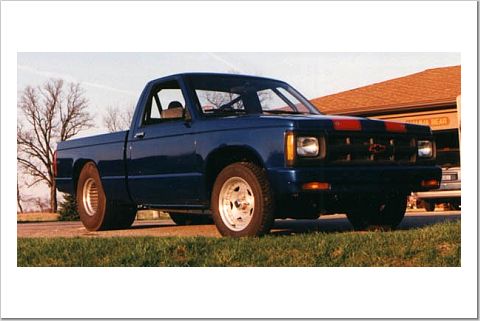
This truck was built to be track ready, or driven on the street. At the time of completion, all NHRA required safety items were built into this truck's design. I built this truck in 1997. I can honestly say this truck has less than 5000 miles on it since I built it. This truck is an AutoRama 1997 First Place winner, pictures of the plaques are shown below. If you are a Michigan resident and are interested in buying / trading for my truck, the "REDLINE" plate and registration will be transferred to you.
These pictures closely, what you see represents 2 years of my time, and $26,000 with an NHRA chassis builder. This truck was built "right" with safety and fun in mind. Get ready early for next spring's race season!
Enjoy the pictures.

| Year | 1985 |
| Make | Chevrolet |
| Model | S-10 |
| Chassis | Half-Back, Tube, Pro-built, NHRA chassis builder approved |
| Engine | 1964 Chevrolet 327 High Output |
| Transmission | Turbo-Hydromatic 350 |
| Stall Converter | TCI 3500 |
| Rear Axle | Ford 9" with Wilwood Disk Brakes, Strange Axles |
| Gears | 3.54, Posi |
| Rear Suspension | AVO Coilover with Ladder Bars, Chrome-Moly |
| Body | All new steel panels, fiberglass hood |
| Window Net | Driver only, with locking pin and rail |
| Gauges | AutoMeter Tach, Oil pressure, Water Temperature |
| Ignition | MSD 6AL, Billet 85551 Distributor |
| Tires / Wheels | Centerline, Convo-Pro 15x14, 33x19.5 Mickey Thompson Sportsman, with Tubes |
| Fuel Cell | RCI, 16 Gallon, Foam Filled |
| Seat Belts | 5 Point Driver, 5 Point Passenger |
| Seat Vendor | RCI |
| Shifter | B&M |
| Carburetor / Intake | Edelbrock, with Performer RPM Manifold |
| Headers | Hooker SuperComp |
| Radiator | Griffin 4 core Aluminum |
| Exhaust | Flow Master, quick 3 bolt removal for the track |
| Hood | Harwood Fiberglass, Dzus fasteners |
| Roll Cage | 10 Point, mandatory, reinforced with rear frame mounts |
A closer look at the interior:
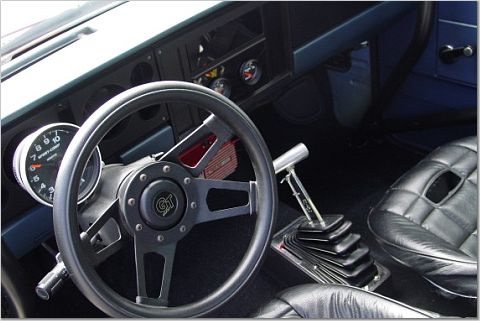
Shown Above: A Grant G/T Steering wheel, B&M Mega Shifter, lighted Auto-Meter Monster Tach, lighted matching oil pressure and water temp gauges. The carpet is black, seats are RCI Molded seats. The factory gauges, radio and fan controls have been removed. In their place, black Lexan was installed in their place. The MSD 6AL controller is installed in front of the shifter, under the dash, and has the 6500 RPM Rev-limited installed. The glove box door opens properly without contacting the roll cage.
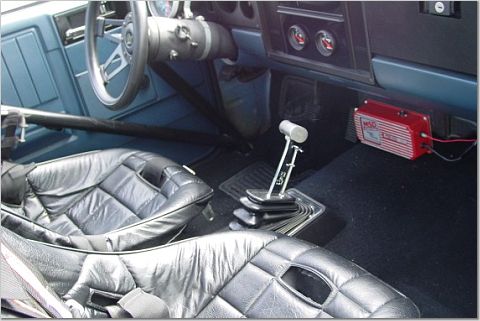
Shown Above: Here you can see a closer view of the MSD 6AL mounted un the center of the lower dash. The cigarette lighter is the manual choke adjustment. The manual adjustment is easily hidden when the ashtray door is closed. The doors have manual windows, to save on vehicle weight. The roll cage bars are mounted low enough that you can easily enter and exit the vehicle. Seats are manufactured by RCI.
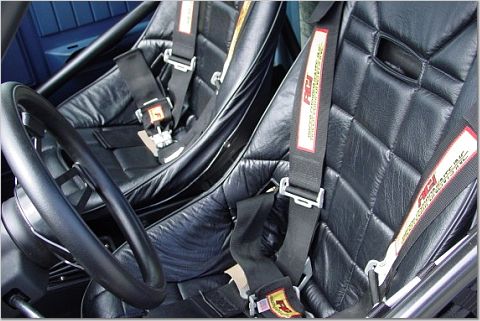
Shown Above: Safety was one of my number one concerns. If it's not built safe, you don't enjoy a vehicle as much. Track inspectors won't let you enjoy it as much either. The driver's seat has the 5 point RCI safety harness, with the quick release latch system. The passenger seat currently has a 4 point RCI harness installed, the remaining harness for the passenger seat is still in the box. Lower harness mounts are bolted to the floor pan, and upper belt mounts are attached directly to the roll cage cross bar located behind the seats. The seat covers are like new, and in perfect condition.
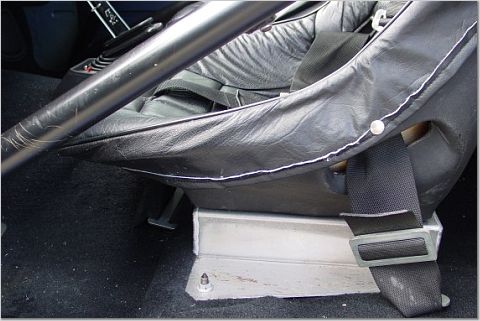
Shown Above: Both Seats are mounted to their own individual hand made aluminum base. These custom fabricated seat mounts are bolted to the factory seat mounts for safety. Also shown are the RCI seat belt / racing harness mounts. Each harness is fully adjustable at the base. These seats are hard mounted, and comfortable. I am 6'3, and fit in this seat, behind the wheel with no problems. It's very comfortable.
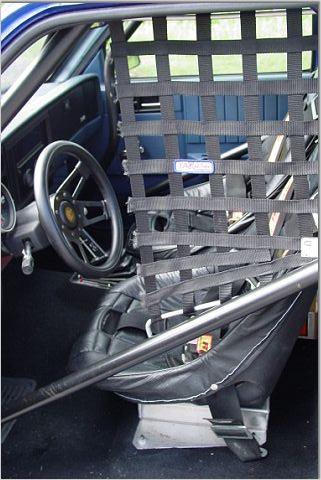
Shown Above: From this view, you can see the window net, which is required in some classes at the track. The window net is mounted to upper and lower rails with a cotter pin used to lock the upper bar into a welded steel tab on the upper roll cage. The lower window net bar is mounted to welded steel tabs on the roll cage. The side protection bar of the roll cage is mounted low enough to allow easy access into the vehicle. Mounted just in front of the drivers and passenger seat is a single bolt, which when removed will allow for quick removal of the Flowmaster mufflers. One bolt within the cabin, and 3 from each collector, and the vehicle is ready for open-header racing. Both mufflers are easily removable within 10 minutes.
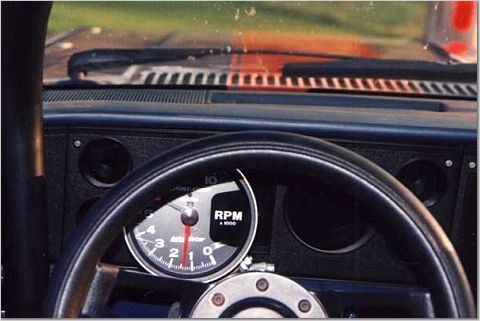
Shown Above: What more do you need? A monster tach. All factory gauges are removed, the gauge cluster is covered with black tinted Lexan. All factory wiring is retained behind the black Lexan, and if desired, the factory gauges can be re-installed. The speedometer sending cable is still connected inside the dash. Michigan law does not require a speedometer, so, I didn't install one.
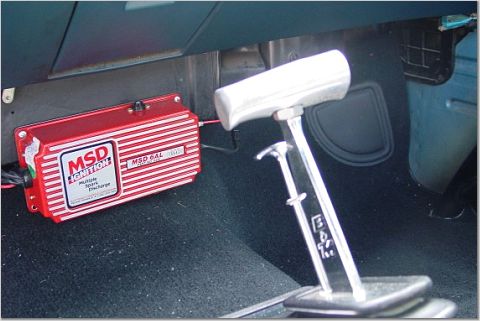
Shown Above: The MSD 6AL can be your best friend. Why? It's one of their few models that includes a rev-limiter chip. I have the 6500 RPM chip installed in this unit. The 2 stage controller can be added to this MSD. The chip is located at the bottom of the box, and can easily be changed with a higher, or lower chip if desired. This MSD 6AL is connected to the MSD Billet 85551 distributor, with brand new MSD wires. The B&M Star-Shifter includes reverse lockout.
So, enough with the interior, how about a look around the exterior:
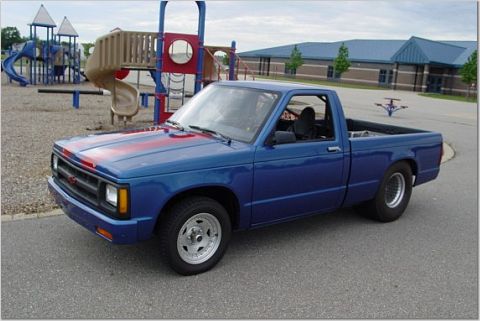
Shown Above: The color is Hawaiian Orchid Blue, which, if you are a Corvette fan, was a limited production color only offered on the Grand Sport. To buy this paint, you had to provide a VIN number. A friend owns a Corvette shop, and helped with the VIN number for the paint in 1997. The stripes on the hood bring back the classic SS style in bright red. The bumper was painted to match the vehicle. When I built this truck, I used all new sheet metal for the fenders, doors and tailgate. Notice that there is no fuel filler door, the door, original tank and fuel system was removed.. The wheels are Centerline Convo-Pro wheels, aluminum with nearly new Mickey Thompson Sportsman tires. The only chrome items on the exterior of this truck are the door handles. The windows roll all the way down, and the wipers are operational.
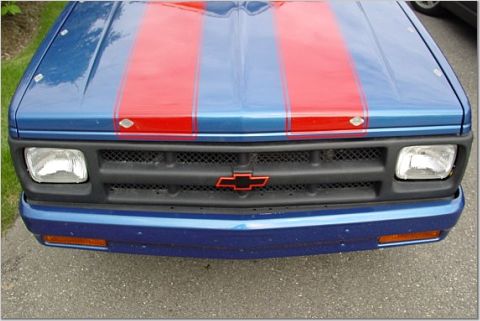
Shown Above: I installed the newer 1991 style in place of the older grille. In doing this, I also replaced the front core support with the new style core support, to allow for the new grille, again all new parts. I also installed the S-10 SS style Chevrolet badge. It was stock, and looked nice. If you look closely, you can see that the SS style stripes on the hood also include the traditional outer pin-stripe. The SS style stripes are rounded at the bottom of the hood, and run the full length of the hood and onto the cowl. The Harwood fiberglass hood is mounted using 10 Dzus quick release fasteners. The Harwood specialized screw driver is included.
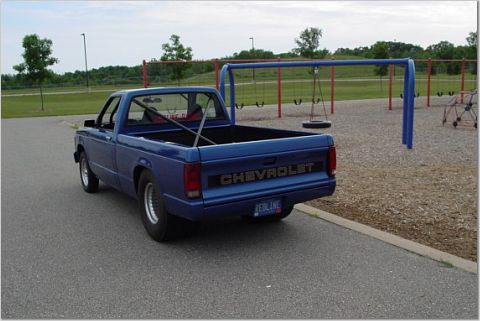
Shown Above: The tailgate was upgraded to the 1991 style, with the large "CHEVROLET" displayed across the back. The rear bumper was replaced with a fiberglass roll pan. The rear look is clean. The roll cage passes through the top of the rear Lexan window. The height of the rear of the truck is set to stock height, and is completely adjustable via the adjustable coil-over suspension.
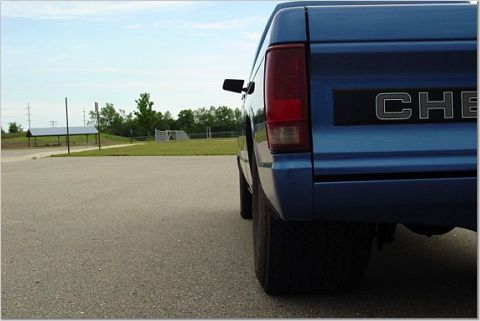
Shown Above: The body lines are straight and true, and chassis was built with the intention of keeping the rear tires outer edge in the same location as a stock vehicle. This allowed for use of body panels that don't require trimming. It kept the truck looking closer to stock, and very clean. The rear tires are Mickey Thompson Sportsman 33x19.5x15 tires, with tubes.
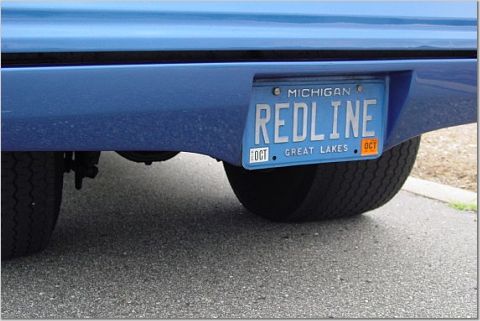
Shown Above: The fiberglass roll pan mounts in the stock location for a rear bumper, attached on the sides. The pan is painted to match the vehicle. The "REDLINE" plate will be included with the vehicle if the winning bidder is a resident of Michigan. If you are not from Michigan, the plate will be retained by myself.
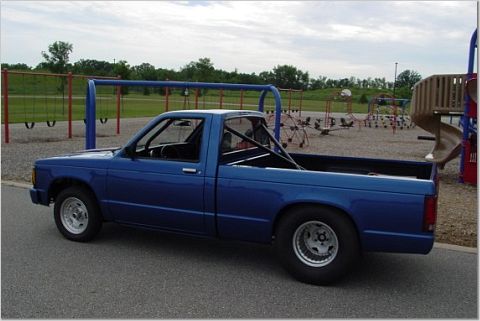
Shown Above: From the side, you can see that the tires remain in the stock location, and the only other visible difference between this vehicle and a stock vehicle is the roll cage. The fuel filler door has been replaced and smoothed, since it is not needed. All body lines are straight, and aligned to appear as stock.
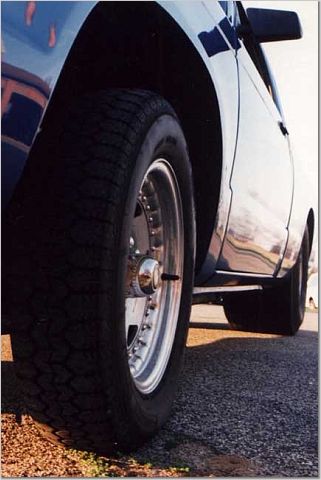
Shown Above: From here, you can see that tread remaining on the front tire, as well as how narrow this tire is. The front tires include the Centerline center caps, as well as solid lug nuts. The inner fender liners were not replaced when building the front end. This was to aid in the cooling of the engine compartment. Again, you can see that all body lines are straight and true.
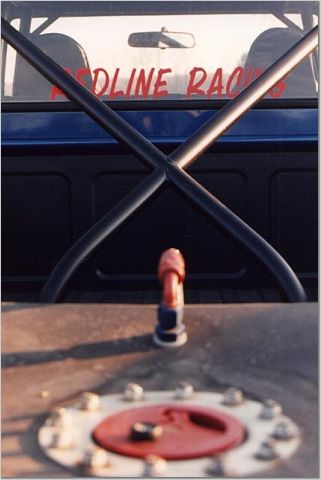
Shown Above: The bed of the truck was painted in flat black, as well as the roll cage, both in the cab, as well as externally. The entire cage was welded together, to ensure a solid and safe roll cage. The cage itself is bolted through the bed to matching mounts that are welded to the frame of the truck. Also shown in this picture is the rear Lexan window, and top of the RCI 16 gallon fuel cell, which is foam filled to prevent "sloshing" of fuel when racing.
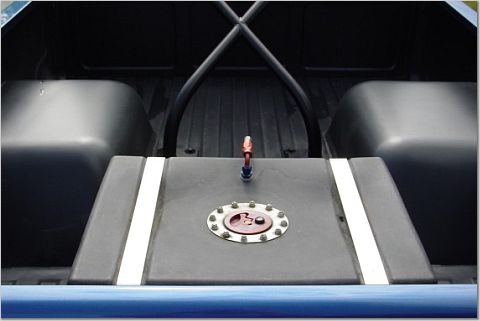
Shown Above: Here is some trick custom work that will make a "body shop" look twice. When I was building the bed of the truck, I had the wheel wells widened to accommodate the wider tires. In doing so, the wheel tubs were widened to appear as stock. Even the beads that connect the wheel wells to the bed of the truck appear as if they were stock from the factory. It's a trick piece of work, and looks really cool. The fuel cell is mounted with 2 straps that bolt to the truck's bed. The filler opening of the cell is vented, and locks. An additional vent tube is located at the top of the cell, and runs down through the bed and under the vehicle.
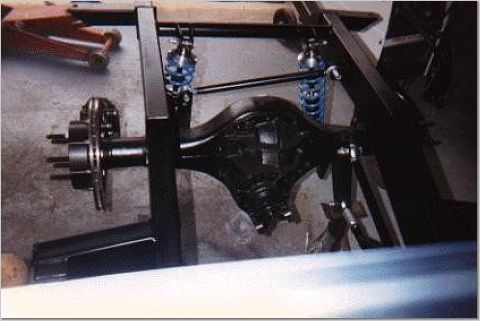
Shown Above: Here is a closer look at the new rear chassis. Note that this is a completely new Ford 9" rear axle assembly, with Wilwood vented disk brakes. Strange axles were used, as well as Koni AVO Coil-Over adjustable suspension. 4" long lugs are used, as required in some race classes. A Panhard bar was used for stability, as well as 4 point ladder bars. Just outside of this image, is a welded tube drive shaft loop. I didn't use one of those simple "bolt-in" loops, it's made of solid steel, welded to match the rest of the chassis. Chrome-Moly ends were used when installing the ladder bars. This chassis, with the full cage allows for the ability to run up to 700 HP without the chassis flexing. This was under advisement of the chassis shop that built my truck, Pro-Fat Engineering in Comstock Park, Michigan.

Shown Above: The engine is a 1964 Chevrolet 327. Why a 327? Because it's different, and not every person on the block has one. It's strong enough to make a great motor for my truck, and common enough that you can build it affordably. The engine is rated at over 300HP, and runs strong. I also chose this engine because it makes a great street motor that runs on pump gas. There is only 1 belt on this engine, and it runs the alternator. I removed the power steering because it doesn't help you when you are running in a straight line (if you know what I mean). The battery is a brand new (July 2003) 1000 CCA battery. The carburetor is the 650 CFM Edelbrock Performer, with a matching Edelbrock Performer RPM intake manifold. The carburetor is a manual choke configuration. Fuel is provided with a Mallory 140GPH fuel pump mounted to the rear chassis, near the fuel cell. The radiator is made by Griffin, and is a 4 core radiator, the shroud was hand made out of aluminum, it's totally custom. The engine bay was painted flat black to give a clean appearance. The transmission is a Turbo-Hydro 350 with a TCI 3500 stall converter. A B&M shift kit was installed, as well as a B&M transmission cooling system.
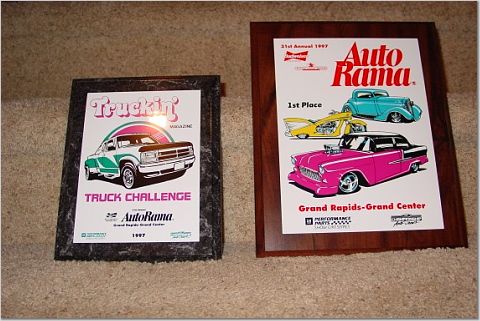
Shown Above: Here are a couple things that you won't see in other S-10s on eBay, plaques to show they are show winners. I entered the AutoRama in 1997, in Grand Rapids, Michigan. After competing against other vehicles, I took home the first place award. The truck was also recognized by Truckin' magazine. Although the awards will not be included with the vehicle, they are here to show that the truck is truly a show class winner.
Questions and Answers:
Who built your truck? ProFat Engineering, of Comstock Park, Michigan. Under the direction of Joe Dochod.
Who built your engine? Burlingame Engines, in Grand Rapids Michigan. 10:1 pistons were used in the build with a cam that was not crazy. The idle is good, and runs really strong. The cam, intake and carb are a good match.
Is the truck fast? Yes, it runs great. Premium Fuel recommended.
What does the truck need? Not a whole lot. Presently, the left turn signal switch does not stay pushed down. I also do not have reverse lights wired into the shifter. All other lights work, including the turn signals themselves, and the brake and parking lights. The truck does not have a horn installed. This vehicle cannot be left outside in the rain, because the fuel cell is vented.
Where can I see it? It's located just south of Grand Rapids, Michigan, in Caledonia (49316)
How do I get in touch with you? Email is the best method of contact, either by clicking here.
Here are a couple of MPEG movies of the truck.
Thanks for checking out my truck!